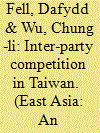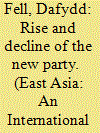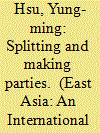| Srl | Item |
| 1 |
ID:
074778


|
|
|
|
|
| Publication |
2006.
|
| Summary/Abstract |
This article examines the evolution of party images in Taiwan between 1992 and 2004. It shows that party images are not immutable, as while the DPP gained more positive images, the other parties gained more negative images during the research period. The results show that the Taiwanese parties have quite distinct party images. Taiwanese voters often tend to use ethnic background and the cross-Strait relations to define the parties. Party images also play a significant role in Taiwanese voting behaviour, even when other variables are controlled. Voters tend to vote for the parties that they have favourable impressions of. The results also have implications for how political parties package themselves to attract more votes and on the development of the party system in Taiwan.
|
|
|
|
|
|
|
|
|
|
|
|
|
|
|
|
| 2 |
ID:
074776


|
|
|
| 3 |
ID:
074780


|
|
|
|
|
| Publication |
2006.
|
| Summary/Abstract |
This paper probes into a hypothesised opportunism towards political party affiliation among local politicians in Taiwan since the power transition from Kuomintang (KMT) to Democratic Progressive Party (DPP) rule began in 2000. Longitudinal changes in election candidates' party affiliation are analysed to see what happened to the KMT's supposedly strong base of local politicians after the change of governing party. The research finds a generally high propensity of election candidates' changing or dropping their party affiliation between elections, and an increased propensity among KMT candidates after 2000. However, defections to other parties are more common in higher elections. In grassroots elections, many candidates flow in and out of their party affiliation depending on the political circumstances, but they rarely change party. Several years after the DPP gained power in presidential elections, the new ruling party is still struggling to build a strong local party organisation.
|
|
|
|
|
|
|
|
|
|
|
|
|
|
|
|
| 4 |
ID:
074779


|
|
|
|
|
| Publication |
2006.
|
| Summary/Abstract |
This paper analyses the growth and decline of Taiwan's first significant third party, the New Party (NP). The NP won numerous seats in the national parliaments in the mid-1990s and received extensive media attention. However, it has shown a steady electoral decline since the late 1990s. Despite its poor recent election performance, the NP should not be regarded as a failure, as it has actually been remarkably successful at achieving its original objectives. By 2004, the KMT's policy positions had become so close to those of the NP that the NP was prepared to promote a party merger and allow its politicians to stand for election under a KMT banner. I challenge the most common explanation that the NP rose when united and fell when divided by bitter factional struggles. Instead a framework incorporating ideology, resources and political opportunity structure is employed to explain the rise and fall of the NP. I argue that when the NP faced a benign political environment in the mid-1990s, its moderate political message and rich human resources enabled the party to grow rapidly. However, after March 1996, the political environment became progressively more hostile, and as the NP's resources were eroded and wasted and the party moved towards a narrow and extremist political project, the party began its terminal decline. The space for the NP became even more limited after 2000, when party had to face intense competition from a powerful new KMT splinter party, the PFP, and a rejuvenated, united and orthodox KMT.
|
|
|
|
|
|
|
|
|
|
|
|
|
|
|
|
| 5 |
ID:
074777


|
|
|
|
|
| Publication |
2006.
|
| Summary/Abstract |
The development of Taiwanese party politics reached a milestone in the 2000 presidential and 2001 legislative elections. The island's pre-existing three-party system underwent a marked reconfiguration. With the split of the Kuomintang (KMT), two new parties emerged but one existing party nearly collapsed. Party politics in Taiwan have shown a continuous process of proliferation of new parties. This paper analyzes the underlying logic that drives the reconfiguration of the Taiwanese party system. A political-institution perspective is employed to show how social cleavages, mixed electoral incentives, and government formation work in dictating the transformation of the party system.
|
|
|
|
|
|
|
|
|
|
|
|
|
|
|
|